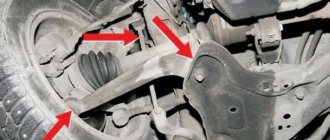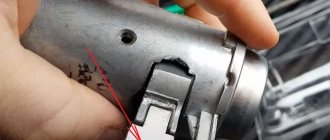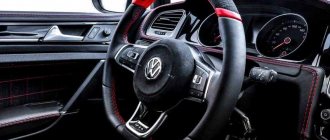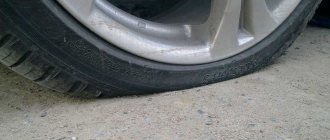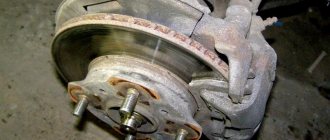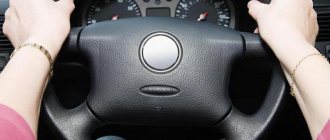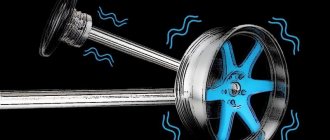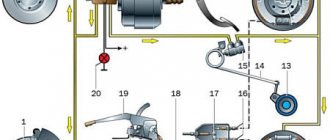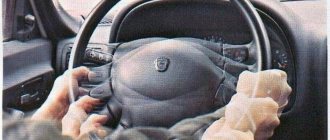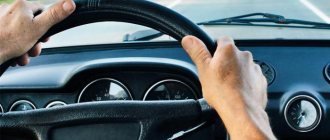When a car begins to make strange sounds, motorists perceive this as a signal to look for possible problems. There is a rational grain in this - as a rule, noise begins to appear when parts wear out or malfunction. Sounds when turning the steering wheel should be especially alarming - if this is a sign of malfunction, then there is a real threat to the safety and health of road users. You should immediately find out why the steering wheel creaks when turning or other sounds appear.
Causes of creaking rack and steering column
If the steering column is not working properly, you will hear a slight knock and noticeable vibration when driving. The cause of this malfunction is a strong mechanical impact on the steering wheel, during sudden braking or a collision during an accident. Such signs indicate deformation of the steering column. Also, strange sounds may come from the coupling.
Of course, the best way to eliminate a squeaking or knocking sound when moving and turning the steering column is to simply replace the non-functioning element with a new part. Unfortunately, the steering column is expensive, which means you need to look for ways to repair the old part. Vibration and noise can be eliminated using lubricant. Lubricating the driveshaft with a small amount of grease can eliminate unwanted noise, but this will only mask the symptoms. It is important to seek help from professionals who can fix the broken part before it completely fails.
Crunching sound (steering wheel turns when driving; car with front-wheel drive)
It happens that when the direction of movement of the car changes, a strong crunching sound is heard. The greater the turning speed and the narrower the radius, the more pronounced it is. There is a feeling that the steering wheel does not play any role here, and that it is the turn itself that is to blame, that the crunch is heard in the area of the loaded wheel (remember that this is the wheel from the outer radius of the turning curve). Most often, this picture is characteristic of turning only in one direction.
Only all-wheel drive vehicles or vehicles with front-wheel drive suffer from such problems. The culprit for this is the constant velocity joint, which in our country is called the “grenade”.
This hinge is a prefabricated element that serves to rotate the front wheel along any axes at a certain angle, without losing the constant speed of the axle. When the car moves, the CV joint rotates all the time, experiencing heavy loads. From time to time, this part runs out of service prematurely, in which case it will need to be replaced.
Checking the “grenade” looks like this. The steering wheel must be turned to one side all the way. After this, you should start moving the car in a circle - in one direction, then in the other. The crunching noise heard during such an operation means that the CV joint is the culprit. If there is vibration that may accompany such a crunching noise, the car must be taken to a professional mechanic without delay.
The so-called boot protects the CV joint from dirt and dust. Often, wear of the “grenade” occurs due to damage to the boot. Actually, the sound of a crunch means that either particles of sand or dirt have penetrated through the boot into the CV joint and the joint begins to grind it all, or the crunch is caused by the collapse of the bearings inside the CV joint.
The machine is not the simplest mechanism. Its steering system and suspension include a huge mass of elements. The suspension and steering differ in their functionality, design, and elements (and differences may appear from model to model; differences may even exist in modifications). For this reason, various noises do not need to be produced only for the reasons described above. For example, noise can be caused by the steering rack, steering column, steering knuckles, struts and joints. An old, falling-off element, which is not directly related to either the suspension or steering, can touch parts of the above systems during a turning maneuver or on road irregularities, causing noise.
In any case, the main thing you need to do when you hear an extraneous sound accompanying the turning of the steering wheel is to determine the other signs accompanying the noise (the car is pulling to the side, a more specific definition of noise). After this, it is necessary to check each boot of the suspension and steering systems, inspect the steering wheel, and check for play.
Problems with the steering rack
The main reason for annoying squeaking noises when turning the steering wheel is a faulty steering rack. Such a squeak can be annoying, and untimely repairs can damage the parts. Unwanted squeaking can occur due to simple wear of the mechanisms, damage to the rack box or wear of the steering tips, which can rub against the rods. In addition, damaged anthers can accumulate dirt and debris, which makes a nasty sound when the mechanism operates.
Also, the cause of an unwanted squeak may be an incorrect setting between the steering rack and the column. It is extremely difficult to make such an adjustment, since all machines have an individual adjustment system, and it is better to trust a specialist.
Troubleshooting Techniques
The rubber creaking of the suspension while driving indicates damage to various oil seals, anthers and protective covers. These parts are not repairable, so only replacing them can save the situation. When inspecting the vehicle's chassis, it is necessary to pay attention to the presence of mechanical damage and the degree of natural wear of all rubber elements.
Diagnostics of shock absorbers
The problematic components of the suspension are shock absorbers, which quickly fail due to the unsatisfactory condition of the roads.
A properly functioning part should not have any oil leaks, and when the vehicle rocks, the shock absorber should dampen vibrations. Note that these signs appear first, in contrast to third-party noises when the car rocks, and are direct evidence of the failure of the shock absorbers. In this condition, the mechanism can still work for some time, but it is better to replace it immediately. You can check the shock absorber like this:
You can slightly extend the life of the shock absorber by replenishing the level of working fluid in it. However, such a measure will only have an effect if its body is intact. In addition, you can replace worn out parts of the mechanism.
Checking the condition of the springs
Sagging springs also negatively affects the performance of the suspension. This is caused by their natural wear due to the aging of the metal. To verify this, you do not need to carry out complex diagnostics. You just need to walk around the car and pay attention to its position. If the springs do not perform their function, the vehicle's ground clearance will be significantly reduced. Please note that camber adjustment cannot be performed on a vehicle with sagging springs.
Diagnostics of ball joints
Checking the lower suspension arms will show the condition of the ball joints.
It is most advisable to carry it out by lifting the car on a lift, or using a pit. Using a pry bar, you should carefully press the silent blocks located on the lower arms. If they are in good working order, there should not be even the slightest play. And their rubber parts do not have any damage (cracks, abrasions, dented places). Ideally, check the silent blocks and ball joints on a lift, or by jacking up the front of the car. After this, you need to unscrew the support mount from the lower arm. Next, we rotate its body to assess the condition of the ball. Evidence of its serviceability is the complete absence of play and the free, effortless movement of the body. Due to the elasticity of the rubber parts of the silent blocks, the lower arm should always be in a horizontal position.
Inspection of silent blocks
Determining the presence of production of these elements is quite simple. To do this, you need to swing the opposite rods from side to side. The presence of play in them is a harbinger of component failure. In this case, it is better to replace them immediately, since further operation of the vehicle with damaged silent blocks has an extremely negative impact on the performance of the suspension.
Steering wheel creaks in place
Interestingly, squeaking when turning the steering wheel in place, just like with the steering rack, can occur due to damaged steering rod boots. It is the debris and dirt in the protection that can contribute to squeaking when turning the steering wheel. This sound can be heard both while driving and while parked. All you need to do is clean the components from dust and dirt with the familiar WD-40 product, and replace the worn boots with a new and high-quality product. But it’s better not to start everything up, and not to wait until the steering wheel squeaks again, but to periodically check the condition of the boots and, if necessary, replace them.
Important! If the steering wheel not only makes a grinding noise when turning, but also wobbles a little and vibrates, the problem is not only in the steering rod, but also in the steering joint. Such a hinge may wear out over time and require replacement. If you do not replace the part in time, the hinge itself may jam, and you need to be reminded what will happen if the steering wheel starts to jam while driving and turns poorly.
Another reason for squeaking when making turns is an insufficient amount of fluid in the power steering. Typically, such a squeak will only be heard when the steering wheel is turned while the car is stopped. The first thing to do is try to replenish the fluid in the power steering reservoir. If this method does not help, you need to carry out a full diagnosis and, if necessary, repair the pump and other power steering elements. These elements are quite complex to repair at home, so it is better to contact a service station.
Incorrect wheel alignment can also cause a crunching sound every time you turn the steering wheel. Diagnostics and debugging are carried out only in car services, using computer diagnostics. The service will set the exact angle of the wheels, which will not only get rid of squeaking, but also help avoid severe wear of the tire rubber.
Creaks under the hood and near the wheels
Creaks coming from the engine compartment and from the wheels can come from both steering and suspension components. These sounds are more dangerous because they indicate problems with these nodes.
If a creaking noise comes from under the hood when turning the steering wheel, it is necessary to diagnose the condition of the steering mechanism. Misadjustment of the rack-gear engagement, wear of bushings and sealing elements often causes extraneous sounds. Here it is impossible to do without repair and adjustment work.
Most often the sounds come from the wheels. Here you should start by checking the tie rod ends. If, upon inspection, damaged anthers are found, the tips will have to be replaced, since the ball elements have already worn out due to dust.
Next, the reason should be sought in the components of the suspension. First, we check the condition of the ball joints of the levers. These elements are activated when the wheels are turned, so they can also become a source of sound.
Then we carefully inspect the shock absorber struts. Often the sound appears because of the anthers. Here the situation is the same as with the steering shaft boots. Rubber gradually loses elasticity or they were originally made of a hard material, so when you turn the steering wheel due to friction, the anthers creak. To eliminate sounds, you can try to treat them with silicone grease, but if this helps, it will only be temporary.
The next element that is worth checking in search of the source of the sound is the strut supports, since they also take part in turning the wheels. Their design uses bearings, which gradually wear out and under certain conditions can create a squeaking sound. These suspension components cannot be repaired, so when they wear out they are replaced.
Try our service station selection service
Creating an application is absolutely free and will take you no more than 5 minutes
When the steering wheel creaks when turning, the driver immediately perceives this sound as a signal to troubleshoot. This is logical, because most often extraneous noise occurs due to a malfunction of any systems or wear of parts. In addition, if the steering wheel creaks when rotating, this creates the risk of an accident, which can lead to dire consequences.
What else could be the reason?
In general, when searching for the source of a sound, you must first check all the moving parts that are involved when turning. Also inspect everything that is located near the steering shaft, mechanism, rods, suspension elements, wheels. For example, a loose bolt or self-tapping screw will make strange sounds when it touches moving elements.
There are also more specific causes of squeaks that have nothing to do with the suspension and steering mechanism, but they appear exclusively when turning. For example, the body may be to blame for the sounds. The components of the load-bearing part are connected to each other using spot welding. When the connection points are broken, the elements begin to rub against each other, and not constantly. When moving in a straight line, the components are stationary, but during turns the forces acting on the body change, which leads to friction and, accordingly, squeaks.
To identify the source of the sound, it is not necessary to go to a service station, just drive the car into the inspection hole and ask an assistant to turn the steering wheel in different directions. Being in a hole, you can very easily determine the cause of squeaks. And then you should act based on the results.
It is enough to simply lubricate the rubber elements to temporarily get rid of the sounds. But if the source is a steering mechanism unit, suspension unit or something else, it is advisable to carry out repair work as soon as possible.
When the steering wheel creaks when turning, the driver immediately perceives this sound as a signal to troubleshoot. This is logical, because most often extraneous noise occurs due to a malfunction of any systems or wear of parts. In addition, if the steering wheel creaks when rotating, this creates the risk of an accident, which can lead to dire consequences.
Possible causes of squeaking
Let us immediately note that there can be many reasons, and identifying most of them on your own is quite difficult. Even specialists will not be able to determine the nature of the malfunction without diagnostics, but at a service station it is advisable for the technician to explain in detail the situation in which this sound first appeared:
- Driving on uneven roads.
- Turn direction (left or right).
- Other possible “symptoms” in the form of knocking noises from under the hood, etc.
Perhaps this will help matters. To summarize, the sources of squeaking can be the following car systems:
- Steering element (most likely). Most often, the steering tips, column and power steering squeak when there is a malfunction.
- Suspension. On domestic cars and foreign cars like Nissan, the steering wheel squeaks when rotating due to a faulty suspension part that absorbs loads when turning. There is a feeling that it is the steering wheel that is creaking, although in reality this is not the case.
- Brake system. If a brake pad is loose, when you turn the disc, for example, it may rub against it, causing a squeaking or knocking noise. But loose brake pads usually make knocking noises, and not just when cornering.
- Chassis.
The front suspension creaks on a classic, help determine the cause
Good day everyone. The situation looks like this - a VAZ 2104 car, after winter the front suspension began to creak, mainly when braking. Well, first of all, I changed the ball joints, because... they were completely dead, but the creaking/grinding did not disappear, but on the contrary, began to progress. Now it squeaks when braking (very loudly) as if it’s hitting something, while pulling the steering wheel and hitting the brake pedal. We looked at the brake discs - everything is in order, they changed the rear drums + cylinders (the rear did not slow down at all). Nothing helps. Yesterday one Kulibin said that this is a “pendulum” and that it is changed quite often on classics (the first time I’ve heard about this). The trapezoid is fine and does not require replacement. I contacted 6 different service stations and they all said completely incomprehensible and different things. We drove with two masters, the reasons given were different (1) brake discs; 2) steering gear). In general, if anyone has anything to say on this topic, please, please, I’ll be happy to listen.
Look, the rubber bands may have dried out, after the winter there was a squeak, the ball joints were changed and everything was gone
So many symptoms. If the steering wheel pulls, it means something is wrong with the front brakes (calipers, discs, maybe something in the system is clogged), or the tire is stupidly flat))). If it hits the brake pedal, then, most likely, the front brakes also have misaligned discs. but you say that they were looked at. Backlash appears from the gearbox. But I’ve never heard of a car steering when braking and hitting the brakes. Ball joints can and do squeak. but again, the brake pedal is not connected in any way, the pendulum is the same. So if the pedal hits you, look for a problem in the brakes, it must be somewhere.
There could be a lot of reasons. Just creaks in the suspension - most likely silent blocks. But judging by what is written, this is not your case. Check the wheel bearings and see if the bolts holding the front brake calipers are loose. Look at the discs yourself - the rebound may be due to the fact that the discs have moved. Is your pendulum on bushings or bearings? If it is on bearings, check the axial play (use a mount from below to rub the long rod of the trapezoid and see how the pendulum shaft behaves). If it's on bushings, try tightening it slightly. In the steering wheel - first, check what is splashing inside. Oil, or rusty-watery emulsion. Well, check the adjustment too. Check the protective covers of the brake discs to see if they are bent so much that under some conditions they touch the disc itself. If possible, bend them as far as possible from the disk (without fanaticism, of course
). And check the hub bearings carefully. Even if you don’t mind, I would advise you to remove the hub and visually check the internal bearing. At the same time you can change the lubricant there. I recently had such a problem. The internal bearing fell apart, and when braking, there was also some pressure in the pedal, because... The brake disc started to slip. In any case, please post if you find the reason. Really interesting
Thank you very much for the advice, I crawled under the car))
By the way, TROLL
, I reminded you about the hub, oil was leaking out of my front left wheel for a while, probably the bearing had run out. I’ll definitely write back!)) Thanks again!
“The steering wheel is pulling” - the side from which the steering is pulling is braking poorly. Springs can easily creak. Wash the sand suspension with the wheels removed. Wheel bearings do not creak, they sag or rumble (but this is no longer under braking and this is already a clinic). The steering gearbox and pendulum will start to push into the steering wheel when the steering wheel is turned and the suspension is playing, and not into the brake pedal (any play in the steering wheel gives into the steering wheel, the standard gearbox play of 3-5 degrees is usually distinguishable from the play of the pendulum, knuckles and trapezoid) In general, a grinding noise front brakes usually indicates that the linings have worn down to metal (well, this is also a clinic), and jerking during braking indicates uneven wear or cracks in the discs, that one of the drums has gone sour, and less often - about the internal hub bearing (but you can just hear it while walking). If you blame the suspension, you need more data (braking, acceleration, pits on the left side, on the right side, turning).
Kuder
, while driving everything is fine, although when I slowly trudge through the yards, I can still hear the creaking. What confuses me more is the rhythmicity of the grinding noise - when you press the brake, it starts to creak, as if it’s hitting something, and as the speed decreases, the frequency of the “squeaking” decreases + something still creaks. When you rock the car in place, you don't hear anything. Now it seems that because of this, the outboard bearing has also begun to bounce - first at 2 thousand revolutions in second gear, and now in third it has begun to vibrate, but this is not what quickly disappears as soon as I pick up speed. Apparently it's time to climb up and change the entire chassis at the front. I've been struggling with this for two months now.
A friend had a similar problem, everything was solved by replacing the wheel bearings.
There was a creaking noise when the silent blocks were not tightened. Tightened it, it became normal.
A couple of months passed and I finally found what was creaking there. As it turns out, it’s not the suspension at all, but the left side member has burst and the body creaks on bumps and when you brake. We need to cook. Thanks again everyone for the advice.
That's how it happens. Good luck in welding
Thank you. But I refreshed almost the entire suspension =)
Often, when operating a vehicle, symptoms of malfunction appear that do not seriously affect driving comfort, but are annoying due to their presence. One of these symptoms is a grinding noise in the front wheel when the car is moving. Let's look at the main reasons that can lead to this phenomenon and methods for eliminating them.
Steering wheel
Sometimes poor quality processing of materials in cheap cars can cause characteristic squeaks. Such shuffling is clearly audible in the cabin, but on the street it is almost imperceptible. It has nothing to do with the malfunction of the steering mechanisms. It rarely happens that the steering wheel rubs against plastic that has moved away from its place due to loose fasteners. To eliminate this malfunction, significant efforts will not be required, and any service station will deal with this problem within an hour. It will be necessary to remove the steering wheel, tighten the fastenings of the system that has moved away from its place, and install the steering wheel back.
Steering column
This steering element is equipped with a clutch that can squeak due to lack of lubrication. You won't be able to solve the problem on your own. The mechanics at the service station must remove the steering column, lubricate it, and put it back. In this case the creaking will go away. Also, the reason may lie in the column cross when the cardan rubs against the walls of the boot. The problem is solved with the help of lubricant; some car owners claim that WD-40 helped them.
Last but not least, the reason why the steering wheel squeaks when rotating in a VAZ-2114 may be the curvature of the steering column. In this case, vibrations on the steering wheel and shocks are possible. If the noise level is low, this means that the problem is minor, but sooner or later the steering column will have to be completely replaced. It is very difficult to do this on your own.
Where to begin
A car steering mechanism is a rather complicated thing. It consists of many elements and subsystems. In particular, the design and operating principle become more complicated when the steering mechanism is supplemented with an amplifier. Electric or hydraulic.
It’s worth starting with diagnostics. Moreover, you can carry it out yourself, sometimes even in the field. The essence of primary diagnosis comes down to determining the place where the extraneous sound is coming from. It would also be useful to record under what specific circumstances these creaking noises appear. It can squeak simply when rotating, while the car is moving, only on bumps on the road, or when the steering wheel rolls from the right side to the left, but in the opposite direction everything is fine.
Having determined the source of the sound using simple manipulations and experiments, you can begin further work aimed at eliminating the malfunction.
Please note that creaking noise in the steering mechanism is not normal. That is, its appearance indicates a certain problem, a developing breakdown, wear of some elements.
Continuing to ignore the squeak, at some point the steering mechanism may completely fail and fail.
You can’t even imagine what could happen if a failure occurs at high speed.
Practice clearly shows that such signs appear on a variety of cars, including:
- VAZ 2107;
- Opel Astra;
- Daewoo Lanos;
- Lada Priora;
- Lada Kalina;
- Nissan Qashqai;
- VAZ 2110;
- VAZ 2114;
- Nissan X-Trail;
- Renault Logan, etc.
But the reasons are usually the same for everyone.
I propose to look at the most common provoking factors, and how to deal with them and what needs to be done in certain situations.
Steering rack
The rack mates with the steering column. There is a possibility that the creaking is coming from this very junction. If the steering wheel creaks when rotating on a VAZ-2114 due to the steering rack, then you can check the interface yourself. However, this area is most often inaccessible on foreign cars, so you have to go to a service station. The cause of the squeak is wear of parts or their incorrect adjustment. It could also be:
- Worn steering rack mechanism.
- Loosening the pressure.
- The smallest bend.
In these cases, diagnostics will be required, and practice shows that most often the rack is not repaired, but replaced with a new one.
Conclusions that suggest themselves
As you can see, there are plenty of reasons for the occurrence of third-party noise in the front suspension area. However, most of them do not pose any danger to the further operation of the vehicle. Despite this, experienced auto mechanics advise carrying out a full diagnosis of all elements of the chassis when noise occurs in the suspension area, because only during this process can the condition of all component components be fully assessed.
Restoring the front suspension is not difficult, so any car owner can independently carry out repair work, during which damaged parts will be replaced.
By pouring water on each joint individually, you can determine what is creaking. What it can do: Ball joints Silent blocks Stabilizer rubber bands Tie rod end Spring support Shock absorber bushings
Maybe the spare parts turned out to be left-handed, or maybe they were installed incorrectly. 90 percent are wrong at this point. There are clear rules for installing suspension parts, but many ignore them based on the fact that “it’s a basin.. everything will work anyway, I’m a great super mechanic, I know better”
Because You are not logged in. To come in.
Because you are not a trusted user (phone number is not verified). Enter and confirm your phone number. Read more about trusts.
Because The topic is archived.
Source
Other steering components
When the steering wheel squeaks when rotating, wear of other parts of the steering system cannot be ruled out. In particular, the reasons may be the following:
- Damage to the boots on the steering rod joints. If sand or dirt gets inside due to a leaky boot, this can cause a grinding or characteristic squeak. The integrity of these parts can be checked manually. If they are leaky, they will need to be replaced. It is also worth checking the tie rod end boots. Sand getting into them can also cause the Opel steering wheel to squeak when turning. This also applies to other imported or Russian-made cars.
- Worn steering joints. This problem causes not only a squeak, but also a knocking sound at the initial stage of turning the steering wheel. Worn hinges are never restored, but replaced immediately.
- Lack of lubrication or presence of sand in the steering knuckle bearings. This is accompanied by strong heating of the bearings, which leads to creaking and whistling. The problem is solved by adding lubricant.
Troubleshooting Techniques
The rubber creaking of the suspension while driving indicates damage to various oil seals, anthers and protective covers. These parts are not repairable, so only replacing them can save the situation. When inspecting the vehicle's chassis, it is necessary to pay attention to the presence of mechanical damage and the degree of natural wear of all rubber elements.
Diagnostics of shock absorbers
The problematic components of the suspension are shock absorbers, which quickly fail due to the unsatisfactory condition of the roads.
A properly functioning part should not have any oil leaks, and when the vehicle rocks, the shock absorber should dampen vibrations. Note that these signs appear first, in contrast to third-party noises when the car rocks, and are direct evidence of the failure of the shock absorbers. In this condition, the mechanism can still work for some time, but it is better to replace it immediately. You can check the shock absorber like this:
You can slightly extend the life of the shock absorber by replenishing the level of working fluid in it. However, such a measure will only have an effect if its body is intact. In addition, you can replace worn out parts of the mechanism.
Checking the condition of the springs
Sagging springs also negatively affects the performance of the suspension. This is caused by their natural wear due to the aging of the metal. To verify this, you do not need to carry out complex diagnostics. You just need to walk around the car and pay attention to its position. If the springs do not perform their function, the vehicle's ground clearance will be significantly reduced. Please note that camber adjustment cannot be performed on a vehicle with sagging springs.
Diagnostics of ball joints
Checking the lower suspension arms will show the condition of the ball joints.
It is most advisable to carry it out by lifting the car on a lift, or using a pit. Using a pry bar, you should carefully press the silent blocks located on the lower arms. If they are in good working order, there should not be even the slightest play. And their rubber parts do not have any damage (cracks, abrasions, dented places). Ideally, check the silent blocks and ball joints on a lift, or by jacking up the front of the car. After this, you need to unscrew the support mount from the lower arm. Next, we rotate its body to assess the condition of the ball. Evidence of its serviceability is the complete absence of play and the free, effortless movement of the body. Due to the elasticity of the rubber parts of the silent blocks, the lower arm should always be in a horizontal position.
Inspection of silent blocks
Determining the presence of production of these elements is quite simple. To do this, you need to swing the opposite rods from side to side. The presence of play in them is a harbinger of component failure. In this case, it is better to replace them immediately, since further operation of the vehicle with damaged silent blocks has an extremely negative impact on the performance of the suspension.
Power steering
Note that this unit is the noisiest, and even in a stationary car, when turning the steering wheel, it emits a hum that is clearly audible in the cabin. To fix the problem, you need to add fluid to a special tank under the hood of the car.
However, a lack of fluid does not always cause squeaking. The steering wheel may make sounds when rotating due to wear on the power steering belt, a malfunction of the pump of this system, or air entering the system. A correct “diagnosis” can be made at a service station.
Suspension and chassis
There is nothing to be surprised if the steering wheel creaks when turning a VAZ 2107, because these cars are old, their suspension and chassis are very worn out. If an extraneous squeak occurs when turning the steering wheel of a stationary car, it is worth carrying out a wheel alignment. The reason may be due to incorrect wheel alignment. This procedure is done at a service station, where there is a special stand.
Another possible malfunction of the chassis is wear of the ball joints. In this case, wheel play may also occur. The supports are replaced at a service station, not repaired. Similar symptoms occur with heavily worn strut bearings. Often such parts are lubricated, and the squeak disappears for a while. Ideally, bearings need to be replaced, and their additional lubrication is just a temporary measure.
In all-wheel drive and front-wheel drive vehicles, CV joints may creak when turning the steering wheel. The squeaking becomes louder and more intense as the rotation speed increases. If it is diagnosed that the cause is in the CV joints, then they must be changed urgently, since the malfunction of these elements greatly reduces the level of safety for the driver and passengers when driving.
In VAZ 2110 cars, the steering wheel may creak when rotating due to old shock absorbers that have served their purpose. The fact is that during a turn, the load on one of them increases, and if it is very worn, it will creak. The driver gets the impression that the steering wheel is creaking. Additionally, the shock absorber will knock when driving on uneven surfaces.
Causes of knocking and solutions
Diagnosis of problems with the steering wheel
- A failed ball joint. In this case, it may simply burst. This entails the wheels turning inward or outward in an unnatural way. The car is unable to move on its own. The only way out is to replace the hinge with a new one.
- A failed grenade. If a knock is heard when turning the steering wheel to the right, then the left grenade is loaded. Naturally, to solve a problem such as a knocking noise when turning the steering wheel to the left, you should replace the right grenade and vice versa.
- Wear of stabilizer bushings. To solve the problem, you need to purchase silicone grease and simply spray it on the bushings.
- Steering rack malfunction or weakening. Diagnostics will help identify the problem and repair/replace the spare part.
- Loosening the engine crankcase protection bolts . To do this, you need to tighten the bolt, or replace it if the thread is broken. It is rare that a tap needs to be used to create a new thread.
- It is possible that after replacing the wheel the nut was not tightened properly , then a knocking noise may appear after an unsuccessful replacement, and over time it increases with vibration. The solution is to tighten the nuts to the desired torque.
- Considering the quality of spare parts and the conscience of sellers, a spring can easily burst . The solution to the problem lies in replacing it with a new spring.
- Leaking shock absorbers are another reason for the appearance of a characteristic knocking sound when the car squats. Replacing with a new shock absorber will help solve this problem.
How to determine the cause of squeaking and grinding noises when turning the steering wheel
It is important that extraneous noise while the car is moving can appear at any speed. The driver, turning the steering wheel in one direction or another, hears an uncharacteristic grinding sound even when driving at a speed of 30 km/h. It is noteworthy that when turning the steering wheel, a grinding noise can be heard even when the car is standing still.
Modern car models are equipped with power steering (power steering), thanks to which the steering wheel rotates as easily and silently as possible. For basic configurations, a slight hum or hissing sounds are allowed when the steering wheel is turned to extreme positions. However, there should be no grinding or squeaking noise regardless of whether power steering is installed or not.
Determining the cause of uncharacteristic noises when turning the steering wheel is not easy. The first step is to establish not only the source of uncharacteristic sounds, but also additional symptoms. Indeed, in a number of cases, the driver not only hears unusual sounds, but also feels any problems with the controls.
When diagnosing the cause of noise, several important factors must be taken into account:
- specificity of noise (humming, creaking, grinding, crunching, knocking);
- moments when noise appears (grinding noise when turning the steering wheel while moving or while the car is parked);
- frequency of noise - depending on weather conditions, engine temperature, vehicle load and other factors;
- the appearance of a grinding noise when turning the steering wheel left or right, or in both directions;
- What other symptoms appear along with the noise?
Complete answers to these questions will help a car service specialist determine the source of the problem as accurately as possible and eliminate it.
Why is grinding heard and how to deal with it
If you hear a grinding noise when you turn the steering wheel, this indicates wear on the steering system joints or front suspension. To find out the exact cause, it is worth carrying out diagnostics at a service station and replacing the failed spare part.
Article on the topic: Gasket for the fuel pump: which is better
Noise can occur when turning the steering wheel: a grinding sound when driving, or when the car is stationary. The cause of this noise lies in the failure of the support bearings of the strut or lower ball joint.
If you hear a grinding noise in the wheel when you turn the steering wheel, there can be many reasons. Experienced drivers advise contacting a car mechanic, driving the car into an inspection pit and having a look. Among the reasons are:
- The rubber on the cardan outboard bearing is torn. Stones and rubble can get into it;
- The grinding noise may occur when the pads rub against the discs;
- Another reason could be a loose locking ring.
In sub-zero weather, when turning the steering wheel all the way, a grinding noise is heard due to lack of lubrication. In this case, additional application of lubricant will help.
Common causes of occurrence, noise elimination techniques
The driver of any vehicle should perceive extraneous creaking or grinding noises in the car’s mechanisms as an alarming signal. After all, we are often talking about mechanical wear of an element or its failure, which threatens loss of steering control.
A grinding noise when turning the steering wheel in place and in motion can be caused by a number of problems in the following components:
- errors when performing the wheel alignment procedure;
- steering rack;
- steering column;
- power steering;
- CV joints;
- ball joints;
- silent blocks;
- plastic elements of the interior and body.
Depending on where the sound appears, you need to analyze the problem and fix it.
In most cases of malfunctions, you will have to contact specialists, since troubleshooting the problem yourself will be difficult due to the complexity of the vehicle design and the risk of errors.
Incorrect vehicle alignment
If the source of squeaking when turning and while parking when twisting the steering wheel is the tires, then there is a high probability that the problem lies not in the steering itself, but in incorrect alignment.
Incorrect installation of the front pair of wheels will immediately affect the service life of the rubber: uneven wear will quickly cause it to fail. Therefore, when diagnosing wheel alignment errors, it is recommended to immediately contact a tire shop and repeat this procedure. It is better to use electronic equipment, since in this case errors in setting the correct position of a pair of wheels will be minimized.
Problems with the steering rack and steering column
One of the most common causes of a grinding noise when turning the steering wheel left or right is a malfunction of the steering rack. The creaking of the rack or column is accompanied by strong vibration on the steering wheel. If the noise and vibration are not strong, then further operation of the vehicle is permitted. However, as you drive, the symptoms of wear on the control elements intensify, which makes replacing the mechanism a necessary procedure.
The steering rack on cars produced in the last decade is a very complex mechanism. The car owner can only inspect the boots and determine their condition, but it is advisable to entrust a more in-depth analysis of the problem and repair work to professionals. The slightest mistake when repairing or replacing this mechanism can result in loss of control at high speed, so it is highly not recommended to fix the malfunction yourself.
Common faults
If you hear an extraneous sound in the form of squeaks when you turn the steering wheel, this does not mean that the steering wheel itself is squeaking.
We have previously considered several situations related to the behavior of the steering wheel of a car. In particular, they talked about why the steering wheel pulls to the right, for what reasons it does not return to its original position, and also partially touched upon the steering mechanism in a conversation where they discussed why the car shakes at speed.
There are several main causes of such noise, which are associated with:
- wheel alignment;
- silent blocks;
- bearings;
- steering rack;
- column;
- rod ends;
- plastic casing;
- power steering;
- ball joints;
- CV joints.
Now we will try to briefly go through all these reasons, and help you figure out what is the matter specifically in your situation.
CV joint and ball
If your ball joint is worn out, this may be the likely cause of an unpleasant squeaking and knocking sound when you turn the steering wheel. Moreover, this can happen when the car is standing still or moving.
If the support is at fault, it is recommended to replace it immediately, since the risk of possible failure at speed is very high. To extend the life of this element, simply follow the rules of careful and adequate driving. At the same time, monitor the condition of the anthers. This is a rubber protective casing that prevents dust and other contaminants from entering the ball joint. By adhering to all these rules, the ball will certainly be able to serve its entire service life.
As for CV joints, they are important elements in transferring torque from the gearbox to the wheels. Its failure can be determined by a characteristic pronounced crunch when turning the steering wheel. Moreover, most often it is the external elements that crunch.
Here you need to change either the CV joint itself or the boot, add new lubricant and extend the service life of the unit.
power steering
Although electric boosters are being actively introduced into new cars, hydraulic elements remain the most common.
Power steering noise usually has the same cause on all cars. This is a shortage of special working fluid. The problem is solved quite simply. You need to open the neck on the hydraulic fluid filler tank and add the missing amount. It is only extremely important to use exactly the same liquid that is currently in the container. The combination of different compounds can lead to unpredictable, and most often negative, consequences.
see also
In addition to fluid, a problem may also arise in the form of wear. If the power steering has been in service for quite a long time, be sure to check the condition of the amplifier belt and carry out comprehensive diagnostics.
Wheel alignment
If the squeak comes from the tires themselves, usually when the car is stationary, there is a high probability that the wheels were installed incorrectly.
Everything is simple here. Carry out the wheel alignment yourself or with the help of specialists, and the problem will go away.
Silent blocks
A fairly common reason, typical for hot weather.
If you start to hear a creaking noise at high air temperatures, check the silent seals. An extraneous sound indicates impending complete wear.
When it’s hot, the rubber from which the silent blocks are made gradually dries out, dries out, and decreases slightly in size. This is typical for fairly old parts.
Modern silent blocks on new cars are made of polyurethane. It does not dry out in the heat, and therefore does not usually cause squeaks.
If we miss here too, we move on.
Bearings
When a squeak is heard from the steering knuckle as the steering wheel rotates, it is probably a matter of bearings.
Creaking, squeaking and crackling noises from bearings occur when there is not enough lubrication in them or some kind of debris such as sand and dust gets inside. The problem can be solved by lubrication or complete replacement.
Rack or column
We are talking about the steering rack and steering column.
The creaking from them is quite easy to detect. In parallel with the creaking, a characteristic vibration occurs that appears when the steering wheel rotates.
Usually the source of the squeak is the column coupling. The problem is not the most serious, that is, you can operate the car with it. This can be solved by replacing the column itself.
Another creaking noise may come from the junction of the column and the rack. This is usually due to severe wear or poor adjustment. Sometimes the adjustment can be corrected.
Tips
If the boots are damaged and worn, dust and debris can penetrate directly to the tie rod end. It is they who cause that very creaking of the steering wheel at the moment of turning and when hitting bumps.
To diagnose the problem, you need to conduct a visual inspection. If you find sand or other debris there, you will have to change it.
It is strongly recommended that tie rod ends are always replaced in pairs.
This happens quite often, but mainly on old cars that have been in use for a long time.
see also
Plastic casing
A trivial but common reason why the steering wheel may squeak when turning the steering wheel. It's all about poor quality assembly and gradual wear and tear, which is why so-called crickets form on cars.
Therefore, very often it’s just the plastic casing in which the steering mechanism is located that creaks. Methods for solving the problem may vary depending on the specific vehicle.
If you have any questions, you can ask them in the comments.
Subscribe, leave reviews, tell your friends about our project!
Rubber squeak when turning the steering wheel
The creaking of rubber when turning the steering wheel can indicate a variety of problems in the design of the car. To better understand the source of these sounds, you need to drive the car onto an overpass. In this case, one person in the cabin turns the steering wheel in different directions, and another person under the car tries to determine the source of the rubber squeak.
If the problem lies in the tires on the wheels, then this will be quickly determined. You will either need to perform a wheel alignment or purchase a new set of tires to replace the worn one.
Almost every steering element is equipped with rubber or polyurethane parts. Therefore, any component in the vehicle control system can creak. As a rule, extraneous sounds occur due to a lack of lubrication or when a foreign body enters a rubber element. Therefore, to eliminate the problem, you will need to inspect the part, clean it of sand and foreign bodies, and thoroughly lubricate it. If the rubber element has cracks or tears, it must be replaced.
Quiet or loud hum when turning the steering wheel in place - solution to the problem
This noise is considered typical for all vehicles equipped with power steering. In any mode (parking in place or moving forward/backward), the power steering will emit a low hum when you turn the steering wheel. In rare cases, noise effects will become louder only when the steering wheel is turned in one direction or another.
If the power steering hum becomes louder during operation of the machine, it is necessary to check the mechanism itself. Most often, it is necessary to add power steering fluid to eliminate loud noise when driving a car.
It is important that a strong hum when the hydraulic booster is malfunctioning is always accompanied by difficulty in driving the car. Therefore, this malfunction can be identified in a timely manner when the steering wheel begins to turn more difficult.
Creaking in the cabin
If a creaking sound is heard in the cabin when turning the steering wheel, the cause should be sought in the steering column. In this case, identifying the source should start from the steering wheel itself. There is wiring in the design of the steering wheel, which is often the cause.
Extraneous sound may come from the contact pair of the sound signal or the airbag connection cables (if equipped). By the way, an additional sign of problems with the airbag connection is the lighting of the “Airbag” warning light. This can be resolved by checking the wiring and restoring all connections.
The next thing to check is the steering column. One of the most common causes of squeaks in the steering wheel is friction of the shaft against decorative and protective panels. Removing the panels and treating them with “anti-creaks” helps here.
The steering shaft driveshaft can also produce an unpleasant sound due to wear and contamination with dust. In some cases, lubrication of this element helps, but sometimes the cardan needs to be replaced.
The last place in the cabin where a squeak may appear is the shaft exiting into the engine compartment. Rubber elements used for sealing and protection (boots and seals) “age” over time and lose elasticity, which leads to squeaks. A temporary solution to the problem is to treat these elements with silicone grease. But it is better to replace them with new ones.
conclusions
Any vehicle is a complex system consisting of thousands of different components. Therefore, various kinds of noise can appear both due to serious problems in the mechanisms, and due to the weakening of any simple element in the interior.
However, the car owner must carefully monitor the appearance of various kinds of sound effects both while the car is moving and when turning the steering wheel while parked. After all, only timely diagnosis of a problem can be considered the key to successful repair and safe driving.
It should be borne in mind that any difficulties that arise with turning the steering wheel must be resolved immediately, since the problem may result in the failure of one of the elements of the control system and an accident. You should not ignore the appearance of sounds uncharacteristic of vehicle operation, since the safety and even lives of people depend on it.
Is the squeak really that bad?
Drivers who consider the occurrence of extraneous noise in the suspension area to be a harbinger of a serious malfunction, in most cases, turn out to be right. In reality, provided that the unit is adjusted correctly, extraneous sounds should not appear at all. Note that the source of the squeak can be any element of the chassis, especially this phenomenon occurs due to the friction of parts at the points of their contact. Often, such problems occur on cars with high mileage. However, various types of noise can also occur in the components and assemblies of a new vehicle, which are the result of either improper operation or adjustment, or serious breakdown.

